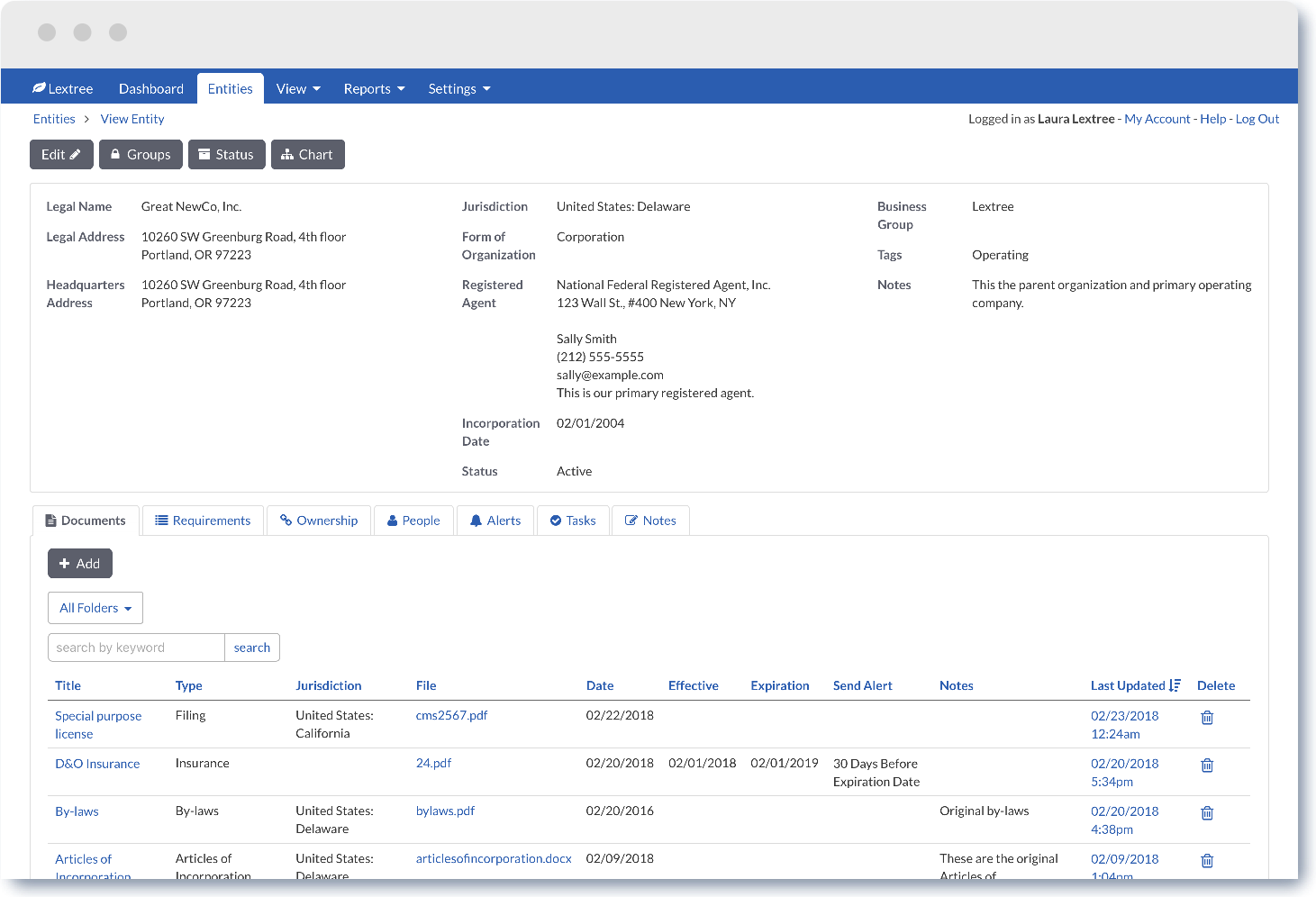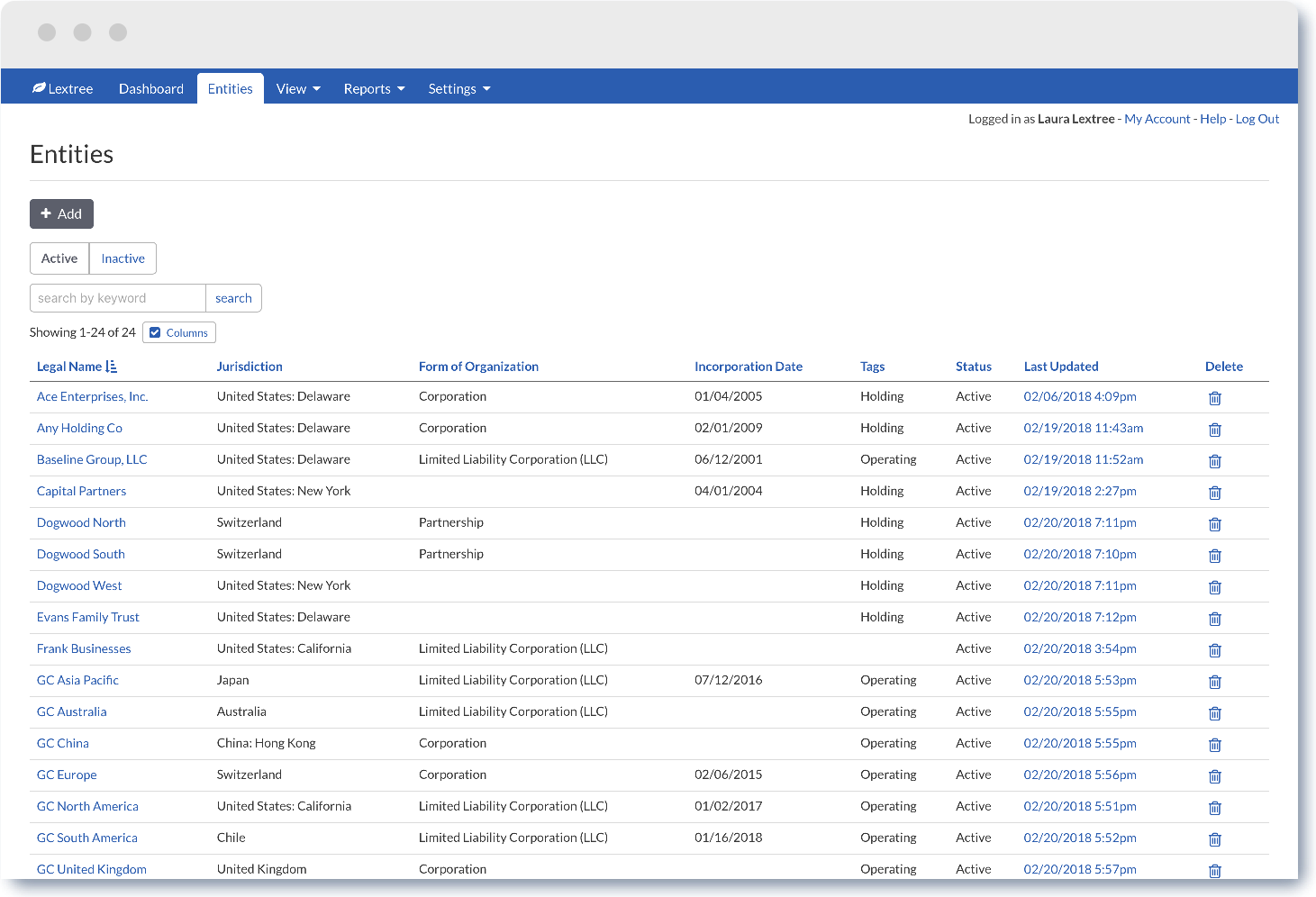9 Principles of Legal Entities
Updated:

Legal entities are critical to manage risk, build businesses, and comply with regulations. These 9 Principles of Legal Entities help business lawyers and their clients maximize the value of legal entities.
Whatever corporate structure your clients use, the practice of legal entity management can improve client engagement and help deliver higher value legal services.
Use one legal entity registry
A corporate registry is a list. A fancy list, but a list nonetheless. A single list of legal entities is the critical first step toward entity management.
Legal entity registry purpose
The corporate registry is a launchpad for access to any legal entity. It is also useful for segmenting and searching for legal entities when there is a large corporate family or client base.
Entity registry and reporting
A single registry also allows for reporting from lawyers to members of management. Imagine easily answering the following questions:
- How many of our legal entities are LLCs?
- How many are taxable and how many have pass-through status?
- Which entities are assigned to which business units?
The inventory of all legal entities is the keystone for entity management.
Adopt data-driven entity management

Shift from legal documents to entity data
To extract more business value from a portfolio of legal entities, we need to look through the documents for actionable data.
Legal entity schema
At a minimum, legal entity data should include the following elements:
- Legal name,
- Trade names (or DBA’s),
- Principal place of business,
- Registered agent information,
- Type of legal entity,
- Jurisdiction of incorporation,
- Organizational documents,
- Filing and compliance requirements,
- Officers and directors,
- Owners, whether LLC members, corporate shareholders, or partnership partners.
Some of these items are single data points, like the legal name. Others, however, are complex data types like officers, directors and owners.1
Whether simple or complex, these data elements give a holistic view of a legal entity on one page.
Distinguish between related and unrelated entities
The corporate registry contains a list of every entity we control or manage. We do not manage every entity which is relevant to our legal entities.
Unrelated legal entity defined
Legal entities which have an ownership interest in one of our entities but is not in our corporate family is an unrelated legal entity. The distinction between related and unrelated entities is important for entity management.
Examples of unrelated legal entities
An unrelated entity might be an outside investor or individual owners. Any legal entity that appears on our company org chart, but not in the corporate registry is an unrelated entity. For those entities, we do not need to track their data and documents.
Generate company org charts (do not draw them)
The data-driven entity management approach allows us to accomplish something special. We can generate company org charts with minimal effort.
Benefits of generated company org charts
When ownership is data, then software can explore the relationships between legal entities to create the legal entity ownership chart.
A data-driven org chart has distinct advantages over a hand-drawn org chart for legal entities:
- The ownership relationships are up-to-date since changes are created in entity management software. With a static, hand-drawn chart there is no way to know that it represents the most recent changes.
- The generational hierarchy is preserved. Software can consistently determine where in the corporate hierarchy each owner should be.
- Complex relationships which involve generation-skipping are handled automatically.
Only need direct parents and subsidiaries
To get the benefit of data-driven company org charts, it is only necessary that you capture the immediate parents and subsidiaries. Software calculates all the other relationships.
Link officers and directors to legal entities
In a corporate family, individuals often serve on many boards and as officers for many companies. One of the most bothersome questions is “What companies does Person A serve as a director or officer?”
With document-centric entity management, this question is time-consuming and fraught with error.
However, entity management grounded in data makes answering this question almost trivial.
Set terms of service for officers and directors
Business lawyers often need to know who was on the board of directors when a certain decision was made. Lawyers can perform that analysis in minutes when we capture the date of appointment and the termination date.
Open-ended terms of service for officers and directors
With most commercial businesses, officers and directors are appointed until their appointment is terminated, voluntarily or involuntarily. In those cases, a lawyer or legal assistant would simply add the termination date when the termination is known.
Predetermined terms of service for officers and directors
Some board structures and non-profit by-laws specify that an appointment to the board of directors is for a specific period, such as two years. If we know the termination date in advance, then we can also set an automatic alert to remind us of the appointment’s impending end.
Data-driven entity management means that lawyers and corporate secretaries retain access to both current and past officers and directors.
Manage jurisdictions as data
Jurisdictions intersect with legal entities at many points during the lifecycle of an entity.
Examples of jurisdiction data for legal entities
At formation, the entity has a place of incorporation. Legal entities have a principal place of business.
Legal entities which are operating businesses across jurisdictions might have to file foreign authorizations to do business in the other jurisdiction.
Businesses which adopt trade names, also called DBAs or doing-business-as names, likely have to file that trade name with each jurisdiction in which they do business.
Jurisdictional data is better than document management
It is tempting to treat all those filings as documents, because they are, well, documents. Unfortunately, doing so causes lawyers to miss two opportunities:
- Tracking legal entity filings as data allows lawyers to contribute to their client’s compliance program because the notion of a filing can be expanded to include any regulatory compliance requirement.
- Most compliance requirements are recurring. Recurring requirements generate legal risk for entities because it is easy to miss future obligations. Entity management reduces this risk with automatically repeating notifications.
Global companies must also deal with an added layer of complexity. Some countries require legal entity filings at the national level, others at the state or provincial level, and the remainders are a hybrid system.
Tracking legal entities globally requires data-driven entity management.
Collaborate with professionals and business leaders
Corporate legal work is technical. Where the work delivers a financial benefit, like tax savings or liability avoidance, clients might appreciate the results.
Traditionally, there is little or no opportunity for business lawyer and client to collaborate on the details of the legal entity. The client has little opportunity to appreciate the details of the lawyer’s work; the lawyer has less opportunity to engage the client on an on-going basis beyond the necessary board and shareholder meetings.
Entity management changes that equation. Business lawyers can now generate automatic notifications about compliance obligations for clients.
They can even collaborate through task management and status updates for each legal entity in the corporate family.
Control compliance requirements
The number and complexity of regulatory requirements grow every year. Many business lawyers miss the opportunity to work with clients on routine compliance matters.
Entity management transforms compliance requirements into client development opportunities. Each compliance requirement draws into jurisdictional data, documents, and deadlines. Entity management harnesses that data so that lawyers and clients can collaborate on effective solutions.
Conclusion
These nine principles of legal entity management allow lawyers and other legal professionals (paralegals and legal assistants) to deliver more value to clients and deepen their client relations.
The leading source of legal entity schema is the Global Legal Entity Identifier Foundation. ↩︎
